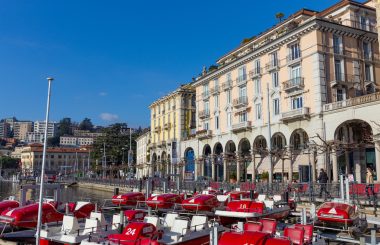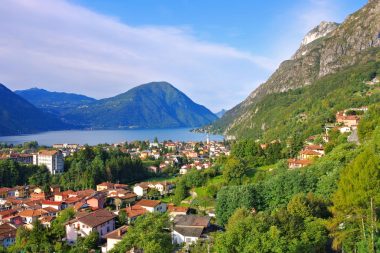Lake Lugano is also called Lake Ceresio and is perhaps the least appreciated by Italian tourists among the large pre-Alpine lakes. It could be due to its complex and sinuous shape that it winds along the Italian-Swiss border with many unknown surprises.

Lake Lugano is the ideal place for those who want a relaxing holiday and a climate that is never too hot. When you camp in one of the places on the Italian coast like Porlezza, you realize that the fame of this body of water is perhaps more celebrated in northern Europe (especially by the Dutch) than in Italy. But here we also find part of our history, in the houses of Valsolda, where the famous novel by Fogazzaro “Piccolo Mondo Antico” is set. On Lake Lugano, you can dedicate yourself to canoeing or small boating and discover the thousand faces of this body of water that surprise us around every bend. We can have fun fishing, hiking or cycling. Or just enjoy the hours between lunch and dinner in the lake.
In short, a holiday that can be the essence of relaxation as a focal point for dozens of sports activities, naturalistic excursions and visits to the centers of the Lombard Prealps and the Canton of Ticino in Switzerland. At the center of all this is the lake, over 48 square kilometers of water bathed by the green of the forest and numerous centers such as Porlezza, Valsolda, Porto Ceresio and the enclave of Campione d’Italia on Italian territory. In Switzerland, the pretty center of Morcote, of course Lugano and many other centers. Porlezza, at the eastern end of Lake Lugano, is a good starting point for visits to the surrounding area. Well equipped with campsites and hotels.
Porlezza, the beautiful one on Lake Lugano

From Porlezza, after about thirty kilometres driving west along the lake, you will reach Lugano, the centre opposite Porlezza. From here we go to Switzerland, especially in the canton of Ticino, where we remember, among other things, that Italian is spoken in Switzerland. The ramified shape of this lake seems to be wedged between the mountains that surround it and that overlook Monte Generoso (1700 m a.s.l.). Getting to the top is easy and not strenuous at all. Once you reach Capolago, take the cogwheel train. Choose a day with clear skies and the panorama of the lake that you will see before your eyes. This will be an experience that will be hard to forget.
A good way to get around is by boat to move comfortably. However, nautical tourism of the water also has pitfalls. Before the excursion, it is necessary to ask the local police to pay the annual tax, which applies to both Italian and Swiss waters. From Porlezza you can navigate along the Valsolda with its picturesque S.Mamete, or visit S.Margherita, an ancient village that can only be reached by a lake on the opposite side of the Gandria customs. Across the border, you can stop in Gandria, Morcote, and Lugano itself. Do not underestimate the distances, because if the maximum width of Lake Lugano is 3 kilometers, then its length is 35 kilometers.
Bosco Impero
A really beautiful place is the Bosco Impero, where you can admire the so-called Rogolone, an almost 400-year-old oak tree with a height of 25 meters and a trunk circumference of 8 meters. The initiative of this forest is commendable: to counteract hydrogeological instability, each boy plants a tree during the tree festival. But the surprising thing is that this happened at the beginning of the last century! When you say, “Lessons learned from the past…” From Porlezza you can reach it on foot in just over an hour.
Another less demanding (an hour and a half) but interesting walk is the one to the Grotte di Rescia. The path inside allows you to admire the stalactites from a natural opening in the waterfall of the Santa Giulia stream.
Lake Lugano Panorama
During a holiday on Lake Lugano, a visit to Lugano is a must, regardless of whether you are based in Italy or Switzerland. In the collective imagination, Lugano is the city of banks and the economy, and if you look around, you can only confirm this. But Lugano will surprise us with its parks with flowers in its gardens, its villas and its summit frame.
The historic center of the city is pedestrianized, the ideal place to admire the city with its Lombard buildings and its many museums.
Culinary delights on Lake Lugano
Let’s assume right away that the large presence of northern European tourism has led many restaurants to adapt the cuisine to the expectations of the northern European tourist in the beautiful country. Pizzerias, spaghetti restaurants and sea fish are more common than the crotti. The latter are caves where the constant cooling temperature allows the preservation of cheese and sausages, and which in recent decades have become real or imagined traditional restaurants. A lake surrounded by mountains develops its cuisine in these two natural environments. Freshwater fish, therefore, among which the carpione fish is very special, are fried and then marinated in vinegar, onion, bay leaf.
Or the fish in green sauce, grilled and marinated in parsley sauce, breadcrumbs with vinegar, capers, anchovies, garlic, egg yolks, olive oil (ideal rinse, agoni and char). Mixed Lake Fry sees large quantities of dreary and agoni or perch and whitefish fillets breaded with egg and fried in butter and sage. Polenta is native to the mountains and valleys, typically buckwheat, pizzoccheri, and Valtellinesi, but is widely grown in the foothills of the Alps. sausages, among which bresaola reigns supreme, and delicious fresh and seasoned cheeses.


